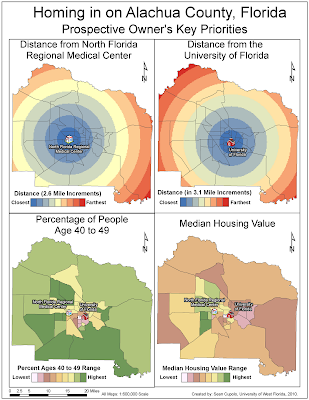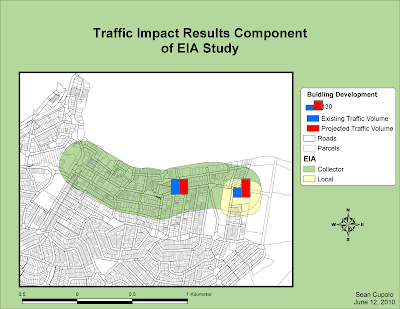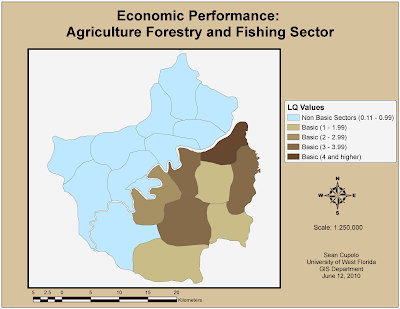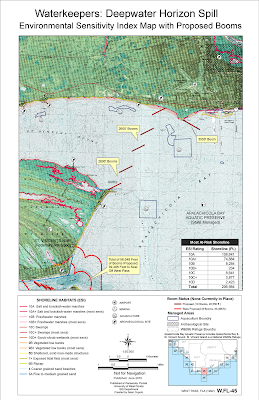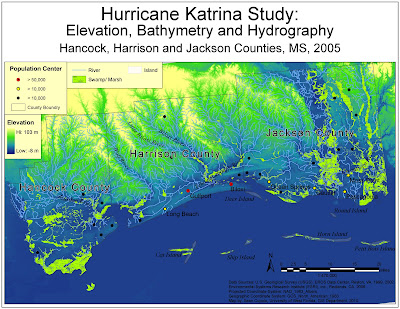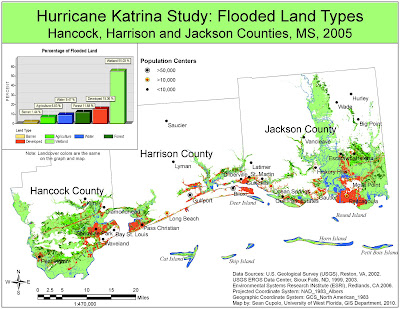I chose to do a similar proximity study to last weeks based on the search for a new home in Marion County, Florida by a couple, John and Wilma Green. The fictitious Greens are searching for a home in mostly rural Marion county in hopes of finding a good value house that fulfills their dream of living on a decent-sized lake, say 200 Acres of more. Mr. Green still needs to commute to his job along Interstate 75 (I-75) and so is also looking for a location that is close to an entrance/exit to I-75, though not too close. The Greens are also avid bicyclists and are interested in finding property that is close to designated bicycle trails. Finally, the Greens are hoping to find a home that is no in a less dense area of the county.
A package of maps has been prepared for the Greens to introduce them to Marion County and highlight areas within the county that may best meet their needs based on the aforementioned criteria.

The first is a base map of the county that highlights some if it's more noteworthy features include the towns, roads and public lands, as well as lakes and bicycle trails. The Greens can use this map to help them become oriented with where places and features are located as they continue to search for a home.

The next map, the Personalized Preference map, has been prepared using the various criteria specified by the Greens as important in their home location decision. They specified six criteria:
1. Proximity to the on/off ramps for Interstate 75
2. Proximity to Interstate 75, but not too close.
3. Areas that have lower population density.
4. Areas that have higher property values.
5. Proximity to designated bicycle routes.
6. Proximity to a reasonably sized lake (preferably on the lake).
The map shows the results of the analysis for determining how close an area within the county is to each of the physical features or how various areas rank in regard to population density and home value.

Finally, the last map shows two weighted analysis preformed using the GIS program by weighting each of the Green's priorities based on how important they were. In the map on the left, the Greens specified that the most important thing to them was vicinity to a lake and so that was rated highest in the overlay (30%). Population Density was next most important (20%), followed by house Value and proximity to bike trails. The highway criteria were each weighted at 10% i hopes of finding properties along that corridor that were good bets. The best choices, several actually adjoining lakefronts are shown as the darkest blue areas.
For the weighted map on the right, concern about proximity to the highway was removed as an issue entirely, though proximity to exits was left in at 15%. The idea was to be that the exit criteria would draw in more areas that ranked high that were close to the highway in the north near the border of Alachua County around Orange Lake. However, somewhat surprisingly, that did not occur. More areas did meet the new criteria but more were in a corridor east of the highway but the Orange Lake area still did not register as a top priority for the home search. It's possible the rankings for the exits/entrances were not recorded in a manner needed to generate the anticipated result. Unfortunately, time was of the essence and since both maps provided useful data for the Greens, they were included in the final home search package.

